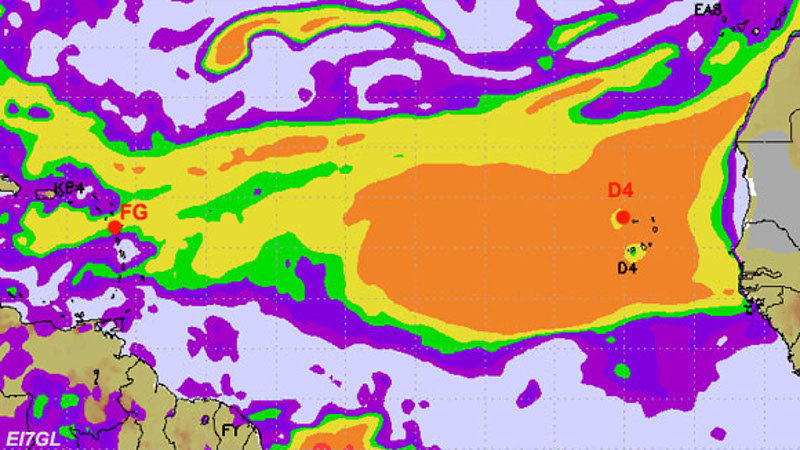Amateur radio is a pursuit with many facets, some of which hold more attention than others for the hacker. Though there have been radio amateurs for a century it still has boundaries that are being tested, and sometimes they come in surprising places.
A recent first involved something you might consider a done deal, a transatlantic radio contact. On June 16th, for the first time ever a contact was made between the operators [D41CV] and [FG8OJ] at 3867 km across the Atlantic ocean from the Cape Verde Islands to Guadeloupe, on the 2 metre (144 MHz) band. If this means little to you it’s worth explaining that the 2 m band is a VHF band, with a range normally similar to that you’d expect from an FM broadcast station. Nobody has ever done this before, so it’s a significantly big deal.
Before you dismiss this as merely some radio amateur chasing grid squares and thus not particularly impressive, it’s worth talking about both the radio mode used and the unusual atmospheric conditions that were carefully sought for the achievement. The attempt was made to coincide with a prediction of transatlantic tropospheric ducting, and the mode employed was [Joe Taylor K1JT]’s FT8. This is a digital mode designed especially for weak-signal and long-distance work. It is theorised that the propagation was so-called surface ducting, in which the signal travels and is reflected between the surface of the sea and a relatively low-level reflective layer of atmosphere. The contact really pushed the limit of what is possible with radio, and while you wouldn’t use it for a voice conversation, proves that there are new tricks in an old hobby for the hardcore experimenter.
We’ve talked about [K1JT] modes crossing the Atlantic before, but of course not at such a high frequency.
















That is something interesting for radio amateurs, which i am not. It is no more miracle to have speak with someone that far away when internet is here. Yes, you need knowledge and skill, but it is like to choose travel around the world on bicycle when you can fly. It is just setting of difficulty.
you must be fun at parties…
Haha yeah I bet. We seem to have a lot of complainers lately who disapprove of other people doing anything that doesn’t interest the complainer.
Its purpose isn’t communication in this sense but atmospheric research. Joe Taylor is a scientist of some repute, and one of his interests is atmospheric physics.
Eh, just a Nobel Prize. https://en.wikipedia.org/wiki/Joseph_Hooton_Taylor_Jr. Winning a Nobel Prize isn’t a hack. I don’t know why this is on hackaday. /s
Points!
Aww, that is something different. Sorry about my post before.
We keep our bicycles tuned up and ready to roll because there are times when the planes can’t fly.
“When all else fails”
K7EJW
THis is one time I really wish there was a block on Hack a day. I do not see you ever adding anything of value after that last statement.
This is about research into electromagnetic propagation in the atmosphere and not about chatting.
Nor am I a radio amateur. But I’m a hacker at heart and thus, I’m reading up on FT8 and on tropospheric ducting.
Rabbit holes, yummy rabbit holes!
As I understand it, FT8 communications involve two computers completing a handshake over RF with either no or next to no opportunity for actual exchange of messages between operators. While that is interesting, I don’t understand the fascination.
The interest here is in atmospheric research. Radio is only the tool, the handshake a means to verify the atmospheric conditions.
FT8 just makes possible the connection of exchanging callsigns and signal-to-noise ratios between operators. To make it conversational, use JS8Call which uses the same protocol.
The magic is that with only a small box of electronics at my end and similar at your end on the other side of the world, we can communicate. No in-between infrastructure required. If the comet tsunami flare war takes out the internet cables, we’ll still be chatting away oblivious. We’ve got 27 degrees this end, 4mm of rain overnight, the angina’s playing up again. Back to you.
This was intended as a reply to Telimektar above, yet here it is in the main thread. I specifically checked that I was replying to such before I clicked. Similar has happened several times recently. It’s all too hard. Not worth the effort. I give up. Bye.
This the contact cause was the special temporary VHF propagation.
Maybe as good morse (CW) mode, not need the computer for that.
The best weak signal mode is the JT9 for HF and JT65 (K1JT) for moonbounce VHF, UHF ….
Greeting
Yeah, I take your point, but my point is that the handshake is done in a very low bandwidth, so if an FT8 path is confirmed then it doesn’t necessarily follow that any sort of two way communication is possible in a reasonable bandwidth.
For the record, the contact has been established in CW (between humans) as well a bit later. Listen to the impressive signal of D4Z (Cape Verde) from FG8OJ location (Guadeloupe) here https://twitter.com/FG8OJ/status/1141453603607064576
Not a ham either, but still very impressive achievement.
Why did the title make me think of Tom Swift and his Repelletron Skyway?
Because Victor Appleton already predicted everything, we’re just rediscovering it as it becomes possible!
The thing is, it’s taken all this time to happen. Propagation, equipment and timing all had to be there. They probably scheduled ut, no random contact.
But stuff was done in the fifties, they got from Hawaii to california. That was when amateur announce began, then requiring a.lot of equipment andbig antennas, but it made things easier.
Various records have been broken since, but it’s a slow process.
Michael